confederate army
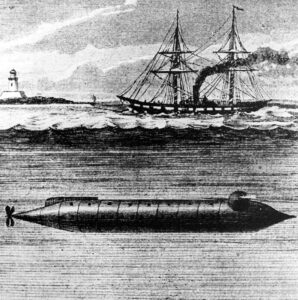 I am of the opinion that most of the United States is populated by good people, who are trying to lead decent and respectful lives. I’m sure there are those who would disagree, and when faced with evil doers, it is sometimes hard to see the good because of the bad, but I think we can agree that the people who agreed with the northern states during the Civil War, far outnumbered those who agreed with the southern states. the Union had a distinctive advantage over the Confederates. There were more states and more soldiers in the Union Army. So, the Confederate Army had to find a way to get ahead of their enemies. Confederates sometimes relied on technical innovation to aid their cause, in the face of such limited resources compared with the Union Army’s sheer numbers and resources. The Union had $234,000,000 in bank deposit and coined money while the Confederacy had $74,000,000 and the Border States had $29,000,000. The Union Army had 2,672,341 soldiers, as opposed to the Confederate Army, which had between 750,000 to 1,227,890 soldiers.
I am of the opinion that most of the United States is populated by good people, who are trying to lead decent and respectful lives. I’m sure there are those who would disagree, and when faced with evil doers, it is sometimes hard to see the good because of the bad, but I think we can agree that the people who agreed with the northern states during the Civil War, far outnumbered those who agreed with the southern states. the Union had a distinctive advantage over the Confederates. There were more states and more soldiers in the Union Army. So, the Confederate Army had to find a way to get ahead of their enemies. Confederates sometimes relied on technical innovation to aid their cause, in the face of such limited resources compared with the Union Army’s sheer numbers and resources. The Union had $234,000,000 in bank deposit and coined money while the Confederacy had $74,000,000 and the Border States had $29,000,000. The Union Army had 2,672,341 soldiers, as opposed to the Confederate Army, which had between 750,000 to 1,227,890 soldiers.
Given the obvious lop-sidedness, especially in the naval conflict, the Confederates could not hope to match the Union in sheer tonnage of ships produced. They didn’t have the funds or the resources to build as many ships as the Union. Many people would actually assume that either the Confederates would lose the war quickly, or it would be mostly fought on land. The Confederates, however, did come up with two famous Confederate naval  innovations…the ironclad warship, CSS Virginia and the submarine, HL Hunley. The HL Hunley was built in 1863. Who would have thought there would be a submarine built that early on.
innovations…the ironclad warship, CSS Virginia and the submarine, HL Hunley. The HL Hunley was built in 1863. Who would have thought there would be a submarine built that early on.
Of course, the Union wasn’t sitting around doing nothing while the Confederates dominated the water. They were busy too. The USS Monitor was built around the same time the Virginia was being retrofitted with iron plating, and those two ships actually clashed at the Battle of Hampton Roads. While the Confederates did get in the war ship game, the superior Northern industrial capacity allowed them to build more than 80 ironclads. The North also built a submarine, called the USS Alligator. It was designed by French engineer Brutus de Villeroi, who had, amazingly, been working on submersible craft for some 30 years. Contrary to what we might think, the concept of a submarine was not a new one. In fact, there was even a primitive one employed in the American War of Independence. The submarines were a far cry from the huge 20th-century submarines of today.
The Alligator was based on an 1859 prototype and was commissioned in 1861 as part of the same flurry of  naval innovation that saw the creation of the ironclad Monitor. The Alligator featured an innovative air-purification system that used limewater to remove carbon dioxide and keep the air breathable for long periods. The Alligator was manned by a 16-member crew, which was later reduced to eight. Also unusual is the fact that USS Alligator had oars to maneuver with. I suppose that wouldn’t seem unusual in its day, but it certainly does today. Sent out on a mission to remove obstructions in Charleston Harbor in advance of an attack by a Union ironclad fleet, the Alligator ran into trouble in the form of a gale on April 2, 1863, while being towed to nearby Port Royal, South Carolina. It was in the storm, and its wreckage was never recovered…but the hunt is ongoing.
naval innovation that saw the creation of the ironclad Monitor. The Alligator featured an innovative air-purification system that used limewater to remove carbon dioxide and keep the air breathable for long periods. The Alligator was manned by a 16-member crew, which was later reduced to eight. Also unusual is the fact that USS Alligator had oars to maneuver with. I suppose that wouldn’t seem unusual in its day, but it certainly does today. Sent out on a mission to remove obstructions in Charleston Harbor in advance of an attack by a Union ironclad fleet, the Alligator ran into trouble in the form of a gale on April 2, 1863, while being towed to nearby Port Royal, South Carolina. It was in the storm, and its wreckage was never recovered…but the hunt is ongoing.
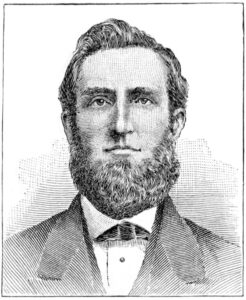
 During the Civil War, things like supply lines and lines of communication were crucial to both sides. The railroads became an important asset, as well as a liability, to both sides, depending on what they were carrying and where it was headed. On April 12, 1862, volunteers from the Union Army, led by civilian scout James J Andrews, commandeered a train called The General, and took it northward from Georgia toward Chattanooga, Tennessee. En route, they did as much damage as possible to the vital Western and Atlantic Railroad (W and A) line from Atlanta to Chattanooga. They were pursued for 87 miles by Confederate forces, trying at first to keep up on foot, and later resorting to a succession of locomotives, including The Texas.
During the Civil War, things like supply lines and lines of communication were crucial to both sides. The railroads became an important asset, as well as a liability, to both sides, depending on what they were carrying and where it was headed. On April 12, 1862, volunteers from the Union Army, led by civilian scout James J Andrews, commandeered a train called The General, and took it northward from Georgia toward Chattanooga, Tennessee. En route, they did as much damage as possible to the vital Western and Atlantic Railroad (W and A) line from Atlanta to Chattanooga. They were pursued for 87 miles by Confederate forces, trying at first to keep up on foot, and later resorting to a succession of locomotives, including The Texas.
Known as The Great Locomotive Chase, the military raid was also called the Andrews’ Raid or Mitchel Raid (after Major General Ormsby Mitchel, who had earlier assisted in the capture of Nashville and accepted the surrender of the city). In the end, as often happens in escapades like this, the raid made sensational headlines in newspapers, but it really had little impact on the war. It didn’t stop supply lines for the South or start new ones for the North.
In February, the Union soldiers captured Fort Henry and Fort Donelson, and Confederate General Albert Sidney Johnston knew he had to withdraw his forces from central Tennessee to reorganize. Johnston evacuated Nashville on February 23rd, and Nashville became the first Confederate state capital to fall to the Union. For Major General Don Carlos Buell, the taking of Nashville was enough, and on March 11th, Buell’s army was merged into the new Department of the Mississippi under General Henry Halleck. It was then that James J Andrews, a Kentucky-born civilian serving as a secret agent and scout in Tennessee approached Buell with a plan to take eight men to steal a train in Georgia and drive it north. Buell authorized the expedition in August 1863. Andrews, a train engineer in Atlanta, was willing to defect to the Union with his train, and without Andrews, taking over the train would have proved difficult. Getting onboard would have been easy enough, but running the train without experienced personnel is next to impossible. Since Andrews was willing to defect, he might also be able to supply a volunteer train crew to assist in running the train, tearing up track, and burning  bridges, so they would have an even greater chance of succeeding. The main target of the operation was the railway bridge at Bridgeport, Alabama, but Andrews had several other bridges in Georgia and Tennessee in mind too. Some of the men from Major General Mitchel’s division, encamped at Murfreesboro, Tennessee, were tapped to be the volunteers for this first raid.
bridges, so they would have an even greater chance of succeeding. The main target of the operation was the railway bridge at Bridgeport, Alabama, but Andrews had several other bridges in Georgia and Tennessee in mind too. Some of the men from Major General Mitchel’s division, encamped at Murfreesboro, Tennessee, were tapped to be the volunteers for this first raid.
The group of raiders moved south forty miles on foot to the Confederate railhead at Tullahoma. Then the caught a train to Marietta, Georgia. It was then that the operation hit its first snag, when Andrews discovered the engineer had been pressed into service elsewhere. Upon inquiring if any of the raiders knew how to operate a locomotive, they found that none did, and the raid was called off. Two raiders were also confronted by Confederate soldiers while trying to cut the telegraph lines, but successfully pretended to be overworked wiremen. Then the raiders returned north to Union lines, arriving about a week after they had departed. Andrews spent several days rearranging the operation and conducting reconnaissance on the Western and Atlantic Railroad before he headed north to federal lines too. The original raiders all refused to volunteer for the second raid, fearing the enemy. One said that “he felt all the time he was in the enemy’s country as though he had a rope around his neck.”
While the first raid was a bust, the second raid went off pretty well. The General was taken while the crew was a breakfast at the Lacey Hotel in Atlanta, and despite all the efforts to catch them, it arrived at milepost 116.3, north of Ringgold, Georgia, just 18 miles from Chattanooga and out of fuel. Andrews’s men abandoned The General and scattered. Andrews and all of his men were caught within two weeks. They even caught two volunteers who had the hijacking. Mitchel’s attack on Chattanooga was a failure.
All of the raiders were charged with “acts of unlawful belligerency.” The civilians among them were charged as unlawful combatants and spies. They were tried in military courts or courts-martial. Andrews was tried in 
 Chattanooga, found guilty, and hanged on June 7 in Atlanta. Seven others were transported to Knoxville and convicted as spies. They were returned to Atlanta and were hanged too. Their bodies were buried unceremoniously in an unmarked grave. Those bodies were later reburied in Chattanooga National Cemetery.
Chattanooga, found guilty, and hanged on June 7 in Atlanta. Seven others were transported to Knoxville and convicted as spies. They were returned to Atlanta and were hanged too. Their bodies were buried unceremoniously in an unmarked grave. Those bodies were later reburied in Chattanooga National Cemetery.
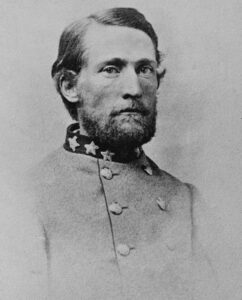 John Singleton Mosby was a Confederate army cavalry battalion commander in the American Civil War. He was also known as “The Gray Ghost.” Mosby’s command, the 43rd Battalion of the Virginia Cavalry was known as Mosby’s Rangers or Mosby’s Raiders. The Unit was a partisan ranger unit noted for its lightning-quick raids and its ability to elude Union Army pursuers and disappear, blending in with local farmers and townsmen. They were so quick and so skilled, that they practically vanished into thin air. Mosby was a legend, and the area of northern central Virginia soon became known as Mosby’s Confederacy. When the war was over, Mosby went on to become a Republican and worked as an attorney, supporting his former enemy’s commander, US President Ulysses S Grant. His political career took him to the US Department of Justice, where he served as the American consul to Hong Kong.
John Singleton Mosby was a Confederate army cavalry battalion commander in the American Civil War. He was also known as “The Gray Ghost.” Mosby’s command, the 43rd Battalion of the Virginia Cavalry was known as Mosby’s Rangers or Mosby’s Raiders. The Unit was a partisan ranger unit noted for its lightning-quick raids and its ability to elude Union Army pursuers and disappear, blending in with local farmers and townsmen. They were so quick and so skilled, that they practically vanished into thin air. Mosby was a legend, and the area of northern central Virginia soon became known as Mosby’s Confederacy. When the war was over, Mosby went on to become a Republican and worked as an attorney, supporting his former enemy’s commander, US President Ulysses S Grant. His political career took him to the US Department of Justice, where he served as the American consul to Hong Kong.
Mosby was born to Virginia McLaurine Mosby and Alfred Daniel Mosby in Powhatan County, Virginia, on December 6, 1833. He was a graduate of Hampden–Sydney College. Mosby’s father was a member of an old Virginia family of English origin whose ancestor, Richard Mosby, 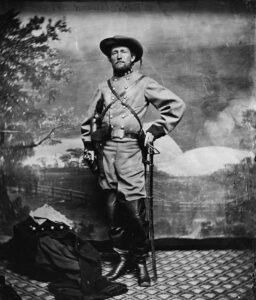 was born in England in 1600. The family settled in Charles City, Virginia in the early 17th century. Young Mosby was named after his maternal grandfather, John Singleton, who was ethnically Irish.
was born in England in 1600. The family settled in Charles City, Virginia in the early 17th century. Young Mosby was named after his maternal grandfather, John Singleton, who was ethnically Irish.
While Mosby was a hero in some ways and a politician, there was another side of him too. Mosby was a Confederate battalion commander, yes, but he was known for his guerrilla military tactics. One of his biggest victories of the war found him and 29 of his men infiltrating the area surrounding the Fairfax County Courthouse in the middle of the night. They caught the Union officers completely off-guard, because they were 10 miles safe behind Union lines. The situation gave Mosby the opportunity he needed. He had captured a general, 30 other Union soldiers, and nearly 60 horses, which was already an incredibly valuable take during the war. In addition, Mosby decided to treat himself, and maybe or maybe not his men, to many of the Union men’s valuables, gathering quite a treasure for himself.
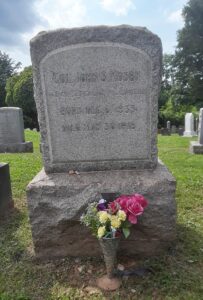
While they were taking their prisoners into Confederate territory, they were informed about Union troops in the area. Mosby decided that he needed to protect his goods. So, he left the group and buried his treasure between two trees. He marked the spot with an X. As sometimes happened, Mosby switched sides politically, and personally, after the war. He chose to support Lincoln and even went on to serve on President Grant’s administration. So, what of the treasure? Well, apparently Mosby never retrieved the treasure he pillaged. Some people reported that he sent Confederate soldiers to dig it up, but they were caught and killed by Union soldiers. And if that was the case, either they hadn’t started digging yet, or hadn’t made it to the location yet, because to this day, the treasure has never been found. I guess he took the location to his grave. John S Mosby died of complications after throat surgery in a Washington, DC hospital on May 30, 1916, noting at the end that it was Memorial Day. He is buried at the Warrenton Cemetery in Warrenton, Virginia.
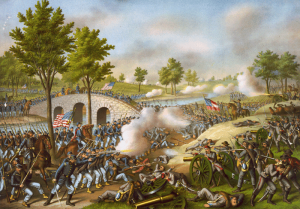 These days, with the many types of bombs nations use for warfare, it would be easy to annihilate an entire town, but during the Civil War…not so much. One bomb dropped on Hiroshima instantly killed 80,000 people. Of course that was on August 6, 1945, and not 1862. September 17, 1862 dawned slowly through the fog. It seemed like the start of a peacefully beautiful day, but looks can be deceiving. That morning, the soldiers were busy, trying to wipe away the dampness, when cannons began to roar and sheets of flame burst forth from hundreds of rifles. The bloodiest one-day battle in American History had begun. The Battle of Antietam was a 12-hour battle that swept across the rolling farm fields in western Maryland. It was this battle between North and South that changed the course of the Civil War, helped free over four million Americans, devastated Sharpsburg, and no other one-day battle would be as bloody.
These days, with the many types of bombs nations use for warfare, it would be easy to annihilate an entire town, but during the Civil War…not so much. One bomb dropped on Hiroshima instantly killed 80,000 people. Of course that was on August 6, 1945, and not 1862. September 17, 1862 dawned slowly through the fog. It seemed like the start of a peacefully beautiful day, but looks can be deceiving. That morning, the soldiers were busy, trying to wipe away the dampness, when cannons began to roar and sheets of flame burst forth from hundreds of rifles. The bloodiest one-day battle in American History had begun. The Battle of Antietam was a 12-hour battle that swept across the rolling farm fields in western Maryland. It was this battle between North and South that changed the course of the Civil War, helped free over four million Americans, devastated Sharpsburg, and no other one-day battle would be as bloody.
The Battle of Antietam marked the first invasion into the North by Confederate General Robert E Lee and the Army of Northern Virginia. It was the culmination of the Maryland Campaign of 1862. Southern armies were also advancing in Kentucky and Missouri, as the tide of war flowed north. After Lee’s dramatic victory at the Second Battle of Manassas during the last two days of August, he wrote to Confederate President Jefferson Davis that “we cannot afford to be idle.” Lee wanted to keep the pressure on in order to secure Southern independence through victory in the North; influence the Fall mid-term elections; obtain much-needed supplies; move the war out of Virginia, possibly into Pennsylvania; and to liberate Maryland, a Union state, but a slave-holding border state divided in its values.
Lee’s army splashed across the Potomac River and arrived in Frederick, Virginia, where he boldly divided his army to capture the Union garrison stationed at Harpers Ferry. A vital location on the Confederate lines of supply and communication back to Virginia; Harpers Ferry, Maryland was the gateway to the Shenandoah Valley. Lee’s link to the south was threatened by the 12,000 Union soldiers at Harpers Ferry. General Thomas Jonathan “Stonewall” Jackson and about half of the Army of Northern Virginia were sent to capture Harpers Ferry. The rest of the Confederates moved north and west toward South Mountain and Hagerstown, Maryland. The Confederate army soon retreated from South Mountain, and Lee considered returning to Virginia. However, with Jackson’s capture of Harpers Ferry on September 15th, Lee decided to make a stand at Sharpsburg.
Lee gathered his forces on the high ground west of Antietam Creek, with General James Longstreet’s command holding the center and the right, while Jackson’s men filled in on the left. The Confederate position was strengthened with the mobility provided by the Hagerstown Turnpike that ran north and south along Lee’s line. Still, the Potomac River behind them and only one crossing back to Virginia remained a risk. Lee and his men watched the Union army gather on the east side of Antietam Creek. Thousands of soldiers in blue marched into position throughout September 15th and 16th as General McClellan prepared for his attempt to drive Lee from Maryland. McClellan’s plan was to “attack the enemy’s left” and when “matters looked favorably,” attack the Confederate right, and “whenever either of those flank movements should be successful to advance our center.” As the opposing forces moved into position during the rainy night of September 16th, one Pennsylvanian remembered, “…all realized that there was ugly business and plenty of it just ahead.”
The twelve-hour battle began at dawn, and for the next seven hours, there were three major Union attacks on the Confederate left, moving from north to south. General Joseph Hooker’s command led the first Union assault. General Joseph Mansfield’s soldiers attacked second, followed by General Edwin Sumner’s men as McClellan’s plan broke down into a series of uncoordinated Union advances. The fierce battle raged across the Cornfield, East Woods, West Woods, and the Sunken Road as Lee shifted his men to withstand each of the Union thrusts. After clashing for over eight hours, Lee’s troops were pushed back, but not broken. Shockingly, over 15,000 soldiers were killed or wounded.
While the Union assaults were being made on the Sunken Road, a mile-and-a-half farther south, Union General Ambrose Burnside opened the attack on the Confederate right. He first sought to capture the bridge that would later bear his name, but a small Confederate force, positioned on higher ground, was able to delay Burnside for three hours. Finally, about 1:00pm Burnside captured the bridge, and then reorganized for two hours before moving forward across the difficult terrain…an unfortunate delay. When the advance did begin, it was turned back by Confederate General AP Hill’s reinforcements, who had arrived in the late afternoon from Harpers Ferry.
Neither flank of the Confederate army collapsed far enough for McClellan to advance his center attack, leaving a sizable Union force that never entered the battle. Despite an estimated 23,100 casualties of the nearly 100,000 engaged, both armies stubbornly held their ground as the sun set on the devastated landscape. The next day, September 18, 1862, the opposing armies gathered their wounded and buried their dead. That night 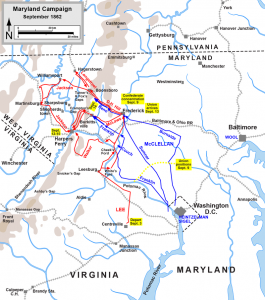 General Robert E Lee’s army withdrew back across the Potomac River to Virginia, ending his first invasion into the North. Lee’s retreat to Virginia provided President Abraham Lincoln the opportunity he had been waiting to issue the preliminary Emancipation Proclamation. Now, the Civil War had a dual purpose of preserving the Union and ending slavery, which the United States had been trying to end since it was founded.
General Robert E Lee’s army withdrew back across the Potomac River to Virginia, ending his first invasion into the North. Lee’s retreat to Virginia provided President Abraham Lincoln the opportunity he had been waiting to issue the preliminary Emancipation Proclamation. Now, the Civil War had a dual purpose of preserving the Union and ending slavery, which the United States had been trying to end since it was founded.
The Battle of Antietam was fought over an area of 12 square miles. Today the site consists of 184 acres containing approximately 5 miles of paved avenues. Located along the battlefield avenues to mark battle positions of infantry, artillery, and cavalry are many monuments, markers, and narrative tablets. Markers describe the actions at Turner’s Gap, Harpers Ferry, and Blackford’s Ford. Key artillery positions on the field of Antietam are marked by cannon. And 10 large-scale field exhibits at important points on the field indicate troop positions and battle action.
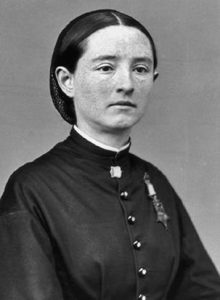 These days, we are all used to having a female doctor taking care of us. Those who haven’t are, nevertheless, not opposed to it. Others really don’t want a male doctor. It’s not a gender issue exactly, but there are women who just don’t feel comfortable with a male doctor, and men who don’t feel comfortable with a female doctor. We might have thought that this would not still be an issue all these years later, but it can be. As long as people are uncomfortable with their bodies, this might be the case.
These days, we are all used to having a female doctor taking care of us. Those who haven’t are, nevertheless, not opposed to it. Others really don’t want a male doctor. It’s not a gender issue exactly, but there are women who just don’t feel comfortable with a male doctor, and men who don’t feel comfortable with a female doctor. We might have thought that this would not still be an issue all these years later, but it can be. As long as people are uncomfortable with their bodies, this might be the case.
In the 1800s, however, this was not just an issue of discomfort, it was just not done. Mary E Walker was born in 1832, in Oswego Town near Oswego, New York. She was never one, to “hide her light,” but rather always stood out in a crowd. Even as a child, she was distinguished for her strength of mind and her decision of character. She grew into a very independent woman. Mary wanted to be useful. She had no desire to sit at home and be “just a housewife.” Mary was a feminist before most people knew what that was. She always had great energy, and in her early years, she wore bloomers, the pantaloon style garb of the radical feminists of the age. She decided to go to medical school, and when she graduated in 1855, she was the only female in her class from Syracuse Medical College. After graduation, she became one of the few women physicians in the country.
When the Civil War began in 1861, Dr Walker, who was 29 years old by then, journeyed to Washington DC and applied for an appointment as an Army surgeon. Of course, the Medical Department was…shocked, to put it mildly, and they quickly rejected her…with considerable verbosity. “A woman’s place is in the home,” or “No one will go to a woman doctor!” Dr Walker was not a woman who could be so easily discouraged. She stayed in Washington, and even served as an unpaid volunteer in various camps. Who would do that, and how did she survive without pay. Then, when the patent office was converted into a hospital, Walker served as assistant surgeon…again, without pay. During her time in the patent-office-turned-hospital, she was instrumental in establishing an organization that aided needy women who came to Washington to visit wounded relatives. It was a need that no one really thought about until she did, and it was probably reminiscent on the modern-day Ronald McDonald House.
As good as she was, Walker was not immune to considerable amounts of abuse over her persistent demands to be made a surgeon. Still, they could not dispute the fact that she also earned considerable respect for her many good works. It was about this time that she decided to abandon the bloomers and adopt a modified version of male attire, with a calf length skirt worn over trousers. She kept her hair relatively long and curled 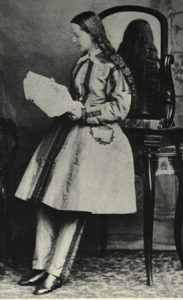 so that anyone could know she was a woman. While she wore a modified version of men’s clothes, she wanted everyone to know that she was a woman. She would not mask her talents by pretending to be a man.
so that anyone could know she was a woman. While she wore a modified version of men’s clothes, she wanted everyone to know that she was a woman. She would not mask her talents by pretending to be a man.
Finally, in November 1862, Dr Mary E Walker presented herself at the Virginia headquarters of MG Ambrose Burnside, and was taken on as a field surgeon. She was still a volunteer, but she was a titled surgeon. She treated the wounded at Warrenton and in Fredericksburg in December 1862. Almost a year later, she was in Chattanooga, Tennessee, tending the casualties of the battle of Chickamauga. After the battle, she again requested a commission as an Army doctor, such a simple thing after her years of loyal service, I would think. In September 1863, MG George H Thomas appointed her as an assistant surgeon in the Army of the Cumberland, assigning her to the 52nd Ohio Regiment. Finally, she had her commission. Now, many stories were told of her bravery under fire. Suddenly, it was ok to talk about just how incredible she was.
Sadly, she served with the 52nd Ohio Regiment for only a short time. In April 1864, Walker was captured by Confederate troops. She had stayed behind to tend wounded following a Union retirement. The Confederates charged her with being a spy and arrested her. The spy accusation came about as a result of her male attire. They said it constituted the principal evidence against her. Dr Walker spent the next four months in various prisons, being subjected to much abuse for her “unladylike” occupation and attire, until she was exchanged for a Confederate surgeon in August 1864.
In October of the same year, the Medical Department granted Dr Walker a contract as an acting assistant surgeon. Finally, 3 years after she first showed up on their doorstep she was given the rank and pay she deserved. Still, despite her requests for battlefield duty, she was not sent into the field again. She spent the rest of the war as superintendent at a Louisville, Kentucky, female prison hospital and a Clarksville, Tennessee orphanage. After she was released from her government contract at the end of the war, Walker lobbied for a brevet promotion to major for her services. Typically, Secretary of War Stanton would not grant the request. Finally, President Andrew Johnson asked for another way to recognize her service. A Medal of Honor was presented to Dr Walker in January 1866. She wore it every day for the rest of her life. She continued in the women’s rights movement and also crusaded against immorality, alcohol and tobacco, and for clothing and election reform. One of her more unusual positions was that there was no need for a women’s suffrage act, as women already had the vote as American citizens. Her taste in clothes never changed, and caused her frequent arrests on such charges as impersonating a man. At one trial, she asserted her right to, “Dress as I please in free America on whose tented fields I have served for four years in the cause of human freedom.” The judge  dismissed the case and ordered the police never to arrest Dr Walker on that charge again. She left the courtroom to hearty applause.
dismissed the case and ordered the police never to arrest Dr Walker on that charge again. She left the courtroom to hearty applause.
In 1916, Congress revised the Medal of Honor standards to include only actual combat with an enemy. Several months later, in 1917, the Board of Medal Awards, after reviewing the merits of the awardees of the Civil War awards, ruled Dr Walker’s medal, as well as those of 910 other recipients, as unwarranted and revoked them. It was an insult of the highest degree, and even after her death on February 21, 1919 at the age of 86, it was not to be forgotten. Nearly 60 years after her death, one of her descendants urged the Army Board for Correction of Military Records to review the case. On June 19, 1977, Army Secretary Clifford Alexander approved the recommendation to restore the Medal of Honor to Dr Mary E Walker. It was the right thing to do. Walker remains the sole female recipient of the Medal of Honor.
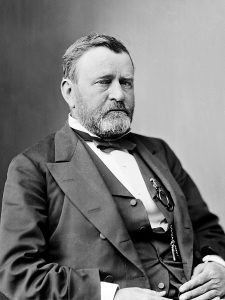 Often we think that the best course of action is to simply attack a problem head on, but that is not always true, as Union General Ulysses S. Grant would find out on June 3, 1864. The United States was deep into the Civil War, and on that particular day, and the Confederate Army was entrenched at Cold Harbor, Virginia. General Grant was about to make the greatest mistakes of his career.
Often we think that the best course of action is to simply attack a problem head on, but that is not always true, as Union General Ulysses S. Grant would find out on June 3, 1864. The United States was deep into the Civil War, and on that particular day, and the Confederate Army was entrenched at Cold Harbor, Virginia. General Grant was about to make the greatest mistakes of his career.
Since the battle began on May 31st, Grant’s Army of the Potomac and Robert E. Lee’s Army of Northern Virginia had inflicted frightful losses upon each other as they worked their way around Richmond, Virginia…from the Wilderness forest to Spotsylvania and numerous smaller battle sites…the previous month. On May 30, Lee and Grant collided  at Bethesda Church. The next day the battle began when the advance units of the armies arrived at the crossroads of Cold Harbor, which was just 10 miles from Richmond, Virginia. There, a Yankee attack seized the intersection. Grant decided that this was the perfect chance to destroy Lee at the gates of Richmond, Grant prepared for a major assault along the entire Confederate front on June 2nd, but his plan was delayed because the necessary troops…Winfield Hancock’s Union corps did not arrive on schedule, the operation was delayed until the following day.
at Bethesda Church. The next day the battle began when the advance units of the armies arrived at the crossroads of Cold Harbor, which was just 10 miles from Richmond, Virginia. There, a Yankee attack seized the intersection. Grant decided that this was the perfect chance to destroy Lee at the gates of Richmond, Grant prepared for a major assault along the entire Confederate front on June 2nd, but his plan was delayed because the necessary troops…Winfield Hancock’s Union corps did not arrive on schedule, the operation was delayed until the following day.
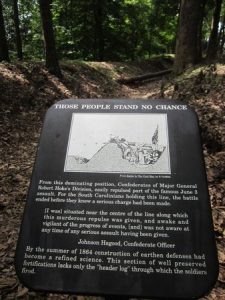
The delay was a tragic move for the Union army, because it gave Lee’s troops time to entrench. Grant was frustrated with the prolonged pursuit of Lee’s army, so he gave the order to attack on June 3, but the entrenched Confederate army had the protection of deep trenches atop a hill, making the Union army have to attack without cover. It was a decision that resulted in a complete disaster. The Yankees were met with murderous fire, and were only able to reach the Confederate trenches in a few places. The 7,000 Union casualties, compared to only 1,500 for the Confederates, were all lost in under an hour. A dejected Grant pulled out of Cold Harbor nine days later and continued to try to flank Lee’s army. His next stop was Petersburg, south of Richmond, where he forced a nine-month siege. While Petersburg would redeem him some, there would be no more attacks on the scale of Cold Harbor.

